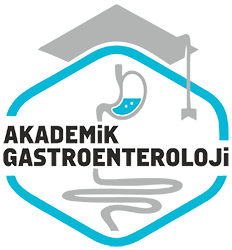Agustos 2020
Nötrositik asitli siroz hastalarinda serum ve asit sivisi TNF-alfa, interlökin-6, nitrik oksit ve myeloperoksidaz seviyelerinin, asit enfeksiyonu açisindan tanisal ve prediktif değeri
Diagnostic and predictive values of serum and acid fluid TNF-alpha, interleukin-6, nitric oxide, and myeloperoxidase in patients with neutrocytic acid cirrhosis
- Ana Sayfa
- Sayılar
- Agustos 2020
- Nötrositik asitli siroz hastalarinda serum ve asit sivisi TNF-alfa, interlökin-6, nitrik oksit ve myeloperoksidaz seviyelerinin, asit enfeksiyonu açis...
Saglik Bilimleri Üniversitesi, Antalya Egitim ve Arastirma Hastanesi, Iç Hastaliklari Anabilim Dali, 1Gastroenteroloji Bilim Dali,2Yogun Bakim Bilim Dali, Antalya
Trakya Üniversitesi Tip Fakültesi Iç Hastaliklari Anabilim Dali, 3Gastroenteroloji Bilim Dali, Edirne
Özet
Giriş ve Amaç: Asitli siroz Hastalarında ortaya çikan spontan asit enfeksiyonu, mortalitesi yüksek bir komplikasyondur. Çalışmamızda, spontan asit enfeksiyonu sırasında, proinflamatuvar sitokinler olan interlökin-6 ve tümör nekrozis faktör-alfanin asit sivisi ve serumda, nitrik oksit ve myeloperoksidazin ise asit sivisindaki düzeylerine bakip, bu sonuçların asit enfeksiyonu açısından tanısal ve prediktif değeri olup olmadigini araştırdık. Gereç ve Yöntem: çalışmaya alinan 40 hasta, steril asitli grup, kültür negatif nötrositik asitli grup ve spontan bakteriyel peritonitli grup olarak ayrıldı. Hastalardan başvuru aninda asit sivisi ve serum örnekleri alinarak saklandi. Daha sonra tüm olgularin asit sivisi ve serumunda immünoradyometrik yöntemle interlökin-6 ve tümör nekrozis faktör-alfa, asit sivilarinda ELISA ile myeloperoksidaz ve enzimatik yöntemle nitrik oksit düzeyleri çalisilarak üç grup birbiriyle ayri ayri kar- silastirildi. Bulgular: Olgularin asit sivisi ve serum interlökin-6 düzeyi ortalamasi kültür negatif nötrositik asit ve spontan bakteriyel peritonit grubunda steril asit grubundan anlamli derecede yüksek bulunmustur. Asit sivisi tümör nekrozis faktör-alfa düzeyi ortalamasi spontan bakteriyel peritonit grubunda steril asit grubuna kıyasla anlamli derecede yüksek saptanırken, serum tümör nekrozis faktör-alfa düzeyi ortalamasinda her üç grup arasında istatistiksel anlamli fark saptanmamıştır. Asit sivisi myeloperoksidaz düzeyi ortalamasi kültür negatif nötrositik asit ve spontan bakteriyel peritonit grubunda steril asit grubundan anlamli derecede yüksek bulunmustur. Asit sivisi nitrik oksit düzeyi ortalamasi arasında ise her üç grup arasında istatistiksel anlamli fark saptanmamıştır. Sonuç: Elde edilen bulgular, asitli siroz Hastalarında, spontan asit enfeksiyonu tanısında, asit sivisi ve serumdaki interlökin-6 ile asitteki myeloperoksidaz düzeylerinin, konvansiyonel yöntemlere yardimci olabilecegini, nitrik oksit ve tümör nekrozis faktör-alfa değerlerinin ise tanısal açidan uygun olmadigini düsündürmektedir
Abstract
Background and Aims: Spontaneous acid infection in patients with acidic cirrhosis is a complication with a high mortality rate. This study aimed to investigate the acid fluid and serum levels of proinflammatory cytokines interleukin-6 and tumor necrosis factor-alpha and acid fluid levels of nitric oxide and myeloperoxidase during spontaneous acid infection and to identify their diagnostic and predictive applicability with regard to acid cirrhosis. Materials and methods: We included 40 patients and categorized them into the following three groups: sterile acid, culture-negative neutrocytic acid, and spontaneous bacterial peritonitis. Acid fluid and serum samples were collected from patients upon admission and then stored. In all cases, acid fluid and serum levels of interleukin-6 and tumor necrosis factor-alpha were investigated by immunoradiometric method, acid fluid levels of myeloperoxidase by ELISA method, and nitric oxide levels by enzymatic method. Subsequently, these three groups were compared with each other. Results: Serum and acid fluid levels of interleukin-6 were significantly lower in the sterile acid group than in the culture-negative neutrocytic acid and spontaneous bacterial peritonitis groups. Serum interleukin-6 levels in the culture-negative neutrocytic acid and spontaneous bacterial peritonitis groups were significantly higher than those in the sterile acid group. Moreover, the acid fluid and serum tumor necrosis factor-alpha levels in the culture-negative neutrocytic acid group were significantly higher than those in the sterile acid group; however, there was no statistical difference in the intergroup serum tumor necrosis factor-alpha levels. The acid fluid levels of myeloperoxidase were also significantly higher in the sterile acid group than in the culture-negative neutrocytic acid group and spontaneous bacterial peritonitis group. We observed no significant intergroup differences with regard to the nitric oxide levels in acid fluid. Conclusion: In chronic liver parenchyma patients with neutrocytic acid cirrhosis, acid fluid and serum levels of interleukin-6 and acid fluid levels of myeloperoxidase may help the conventional methods in diagnosing spontaneous acid infection; however, the serum levels of nitric oxide and tumor necrosis factor-alpha have no diagnostic value



